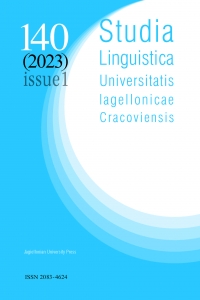FORMULATING HYPOTHETICAL TALK: AN ACTION-DRIVEN APPROACH TO COMMUNICATING STANCE IN BUSINESS MEETINGS
FORMULATING HYPOTHETICAL TALK: AN ACTION-DRIVEN APPROACH TO COMMUNICATING STANCE IN BUSINESS MEETINGS
Author(s): Helena Lohrová, ALMUT KOESTERSubject(s): Business Economy / Management, Sociolinguistics, Business Ethics, Stylistics
Published by: Wydawnictwo Uniwersytetu Jagiellońskiego
Keywords: business meetings; formulations; hypothetical talk; stance triangle; evaluation;
Summary/Abstract: The article focuses on the deployment of hypothetical talk in the CANBEC and CCI cor- pora of business meetings and examines its use as a discursive tool for communicating stance in encounters where participants represent (potentially) incompatible positions. Through the use of hypothetical talk, interactants signal the potential for agreement and resolution by testing the other participants’ position and their preparedness to shift their view. It is argued that although talk introduced to the meeting may be hypothetical, the stance communicated is real. The analysis provides insights into actions applied to re- solve impasse or conflict situations, particularly through the rhetorical move of formu- lating. Formulating aims to resolve or summarize talk at a particular instance in time. The act of formulating requires an evaluative step on the part of the participants in order to consider their contributions or their opposition to the formulation. It is, therefore, of interest to examine how talk that is known to be hypothetical – hence essentially unreal, speculative, potentially untrue or even counterfactual – can be allowed to feature in meetings discourse and to influence a meeting’s outcome. Two theoretical models were applied to understand this – Du Bois’s (2007) “stance triangle” and Hunston’s (1989, 1994, 2011) three functions of evaluation. These offered a new perspective on the role of hypothetical talk in business meetings, where, as the results demonstrate, hypotheticaltalk is used to signal stance, test that of the other participants, and advance the speakers’ goals. By integrating the two models and applying them in order to understand how hypothetical talk is formulated in business meetings, it was possible to conceptualize the process through which meeting participants evaluate and act upon talk, by making “real life decisions” upon information which has initially been introduced to the meet- ing as hypothetical.
Journal: Studia Linguistica Universitatis Iagellonicae Cracoviensis
- Issue Year: 140/2023
- Issue No: 1
- Page Range: 1-25
- Page Count: 25
- Language: English

